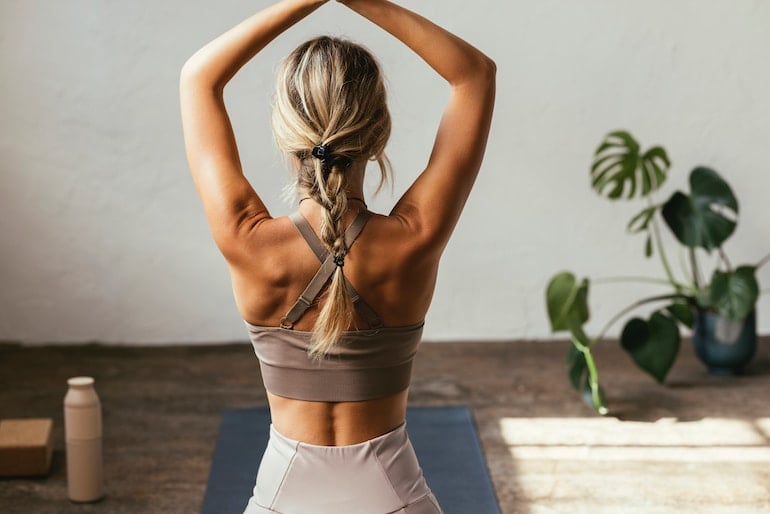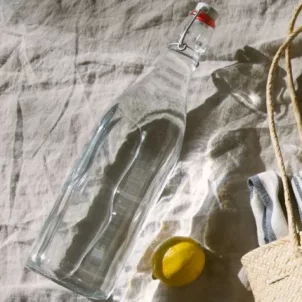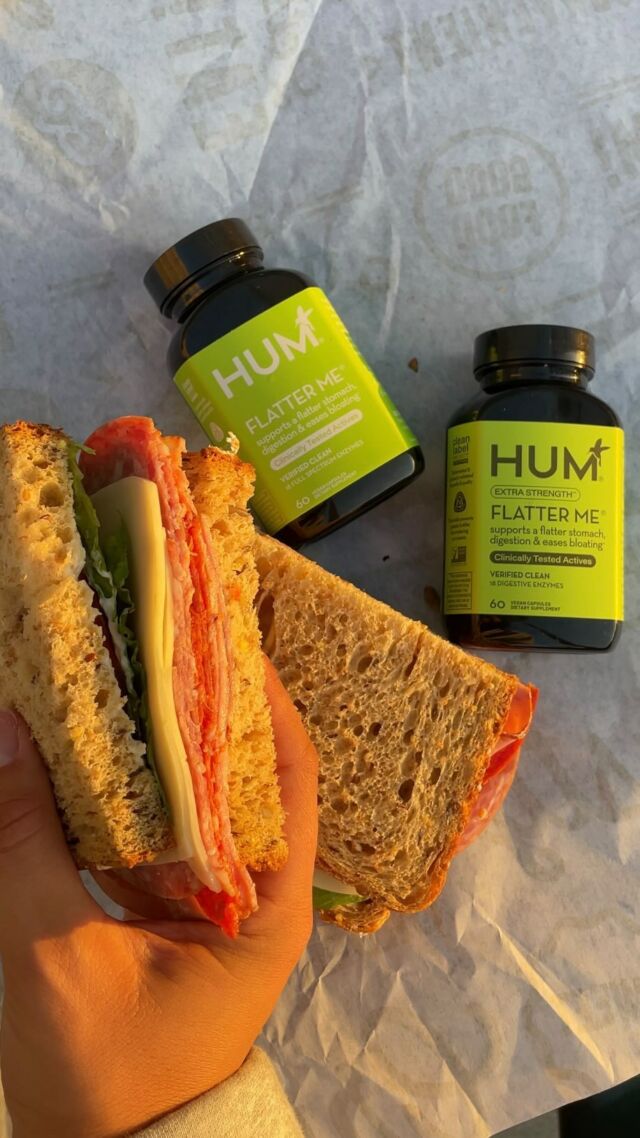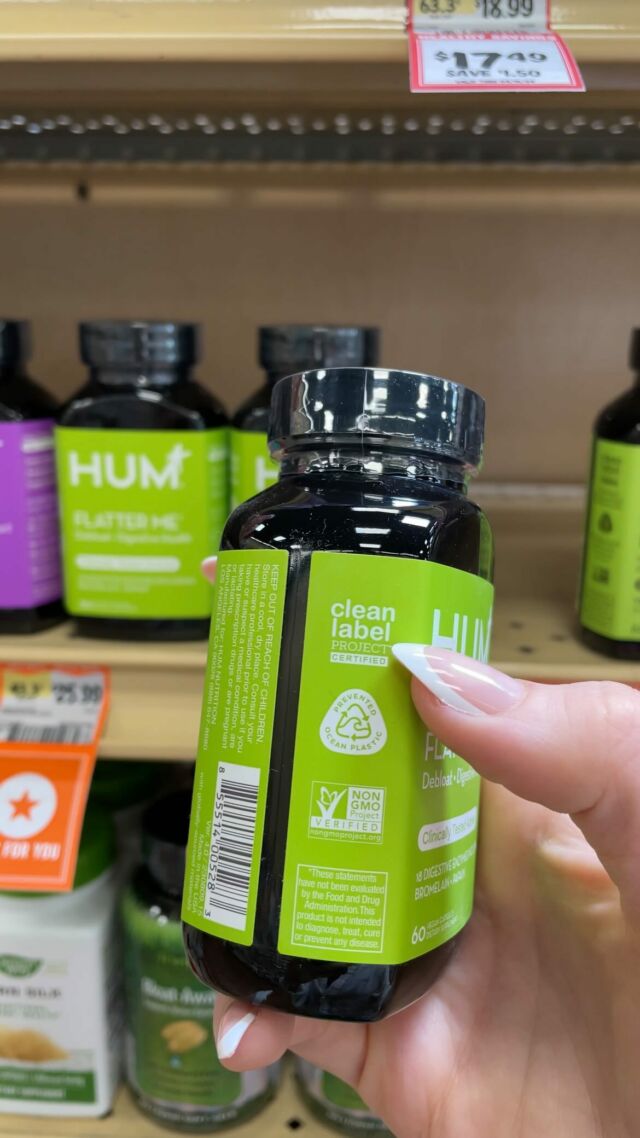One TikTok trend that seems to be here to stay? “That Girl.” While on the surface it’s all about being your best self mentally, physically, and professionally, therapists say this idea is actually toxic—here’s why.
Scroll through any social media app and you’re bound to see the same video: A woman (slim, of course) waking up at 5 a.m. in her aesthetically-pleasing apartment, pouring herself a glass of lemon water, meditating, journaling, reading the same rotation of self-help books, exercising in an expensive matching workout set outfit, applying fancy skincare, making a breakfast full of buzzy health foods (think: smoothie bowls, avocado toast, green juice), and then starting her day. The phenomenon, which appeared last year but is still, somehow, trending, is known as “That Girl.” It’s supposed to be aspirational—encouraging people to be their most productive, happiest, healthiest selves.
I don’t know about you, but I barely have time to squeeze in my morning workout before starting the workday. My breakfast is usually the same four-ingredient smoothie because I’m trying to stay on-budget and on-time. My exercise clothing never matches, and I could simply never fit in a meditation or journaling sesh. I set my alarm for 6:30 a.m. because I have to—not because it brings me joy. And despite being a former beauty writer and having access to every single product on the market, I stick to the same five-step routine because my skin is comedically acne-prone and oh-so-sensitive.
Still, despite this practical approach to my days, every time I see a “That Girl” video, I feel like a colossal underachiever. Am I failing at life because I’m not “That Girl?”
Of course not, but it still feels that way. Experts agree: “In general, anything that establishes an unattainable ideal does more harm than good,” says Pamela Rutledge, PhD, MBA, director of the media psychology research center and faculty in the media psychology program at Fielding Graduate University. “It doesn’t matter if it’s filters and lighting on Insta or lifestyle trends on TikTok.”
I spoke to therapists about what exactly makes the “That Girl” trend so toxic. Read on to see what they said.
What Is the “That Girl” Trend?
OK, let’s back up. What even is the “That Girl” trend? It’s an archetype that rose to popularity on TikTok back in April 2021. And for the record, while the trend emphasizes the word “girl,” these are full-blown women. It’s intended to motivate: to show people what life could be like if they committed to all the small changes they always talk about making (waking up earlier, creating a morning routine, exercising daily, eating healthier). That Girl wakes up at 5 a.m. That Girl does her yoga or pilates every single day. That Girl has a smoothie full of fruits and veggies for breakfast. That Girl has her life together.
Of course, that’s what we all want. But is ‘That Girl’ really the ideal we should all be striving for?
Not so much, according to experts. “It’s depicted as perfect or on top of it all. It fails to represent the days we need extra sleep, leave the unmade bed, or accidentally miss workout class,” says Hannah Tishman, psychotherapist and licensed clinical social worker. You know, real life.
Why Therapists Hate the ‘That Girl’ Trend

Despite its popularity, therapists say you should clear your feed (as much as possible) of this trend. Here’s why.
It Causes Comparison to an Unattainable Standard
With social media, it’s easier than ever to compare your life to others. Here’s the kicker: Any type of comparison on social media has been proven to cause symptoms of depression (so no, it’s not in your head). “Comparison on social media can bring up feelings of inadequacy, fatigue, sadness, loneliness, and anxiety,” Tishman says. “It can increase disordered eating behaviors and an unhealthy relationship with food and exercise.”
The ‘That Girl’ trend takes this comparison to a whole new level—inadvertently shaming people for not having their lives completely together. And, since, if you’re like me, every other video on your TikTok feed is some girl being ‘That Girl,’ it’s especially easy to get caught up in the idea of what we think we should be doing. But Tishman says it’s important to challenge this notion whenever possible. “Remove the word ‘should’ from your day-to-day vocabulary—it can be toxic,” she says. “Replace it with ‘could,’ which allows us to feel like we have agency and choice. Choose what feels good to your mind and body, and what might meet an unmet need in that moment.” And this goes for any comparisons you find yourself making after scrolling social media, not just ‘That Girl.’
The Focus on Hyper-Productivity Is a Recipe for Burnout
The idea that if we’re doing everything perfectly and working hard at all times, we’ll be successful only sets us up for failure. “Waking up early, meditating, journaling, exercising, cooking, and doing all of these things before starting work is actually very beneficial—but doing these things every single day with no break is a recipe for imbalance,” Tishman says. “As humans, we need rest, recovery, and to allow ourselves to have days off.”
Additionally, it pulls focus from what’s really important. “This focus on productivity leads to [people] becoming ‘human doings’ instead of ‘human beings,’” says Ann Kearney Cooke, PhD, psychologist and wellness coach at The Cincinnati Psychotherapy Institute. “Yes it is important to set goals, eat healthy, and move—but it is just as important to connect with your family and friends, rest, be adventurous, and have fun,” Dr. Cooke says.
It’s important to remember that our productivity doesn’t measure our worth (easier said than done). “There are several ways to be successful, and it’s important to define what that means to you individually, not just to do what is trending, which could lead to burnout,” Tishman adds. “Asking yourself the intention behind each of these morning activities can be a great way to slow down, increase mindfulness, and to identify which parts of your routine actually align with what feels good for you rather than what you think you should be doing.”
Routine is important—it keeps us centered and grounded (believe me, I am a Routine Girlie through and through). But, rest and recovery are just as important. Tishman says there should be room for flexibility and chances to ask what our minds and bodies need every day.
It Relies on External Signifiers of Success
Another downfall of this internet phenomenon? It relies on external signifiers of success (an early morning alarm, a daily workout, healthy food in the fridge, fancy skincare products in your bathroom). These may indicate that you’re being The Best Version Of Yourself™, but Tishman begs to differ. “Is that what you need to feel like the best version of yourself?” she asks. “What does it even mean to feel like the best version of yourself?”
For me, it’s feeling healthy, getting enough sleep, moving my body regularly, and enjoying the present moment. Tishman adds that focusing on your actual needs is essential to being the best version of yourself. “Some areas to focus on might be quality sleep, nutrition, quality time with loved ones, having a movement practice, and being capable of saying no to things that may not serve you in that moment,” she explains.
And, as we all know, looking like your life is together isn’t the same as actually having your life together. Changing your entire routine and lifestyle won’t do much without some inner work too. “This trend depicts a self-absorbed lifestyle and doesn’t focus on what really makes people happy and well—healthy connections with others,” Dr. Cooke says. “The goal shouldn’t be ‘How can I become That Girl?’—instead it should be How can I become me: What are my signature strengths? What are my values? How can I express myself?’”
TLDR: No 5 a.m. alarm or colorful smoothie bowl will fix the fact that your needs aren’t being met or that you’re avoiding important inner work. (Not what you wanted to hear, I know.) Plus, your options aren’t limited to what you’re seeing in these videos. If you don’t like smoothie bowls, there are dozens of other healthy breakfast options. If you hate yoga, there are so many other ways to move your body. Not into meditation? You can still do other things for your mental health.
The Trend is Economically Exclusive
Finally, my own personal beef with this trend: It’s wildly expensive. You can’t be “That Girl” without spending hundreds of dollars on groceries, skincare, and matching workout sets. “A lot of women may feel that if they don’t buy these products, they aren’t enough or they aren’t achieving success,” Tishman says.
As a result, they might experience low self-esteem, live outside their means (spending money they don’t have), and suffer from a general low mood. But Tishman says it doesn’t have to be this way. “There are so many ways to live a healthy and balanced lifestyle within your means and being able to be selective about what feels attainable to you is essential.”
How to Practice Self-Care Without Being That Girl
Despite good intentions, therapists agree: Nobody should be trying to be ‘That Girl’. So, how else can you practice self-care outside of this trend? The answer will vary from person to person, but the unifying factor is increasing your self-awareness of how your mind and body feel easy day, Tishman says.
Ask yourself the following questions:
- How does my body feels when I wake up?
- How would I describe my mood today?
- What do I need right now to feel grounded?
“These questions can help you to determine how you can take care of yourself without adding extra pressure from an online trend,” Tishman says.
Screw being That Girl—just be yourself. You’re already enough.









